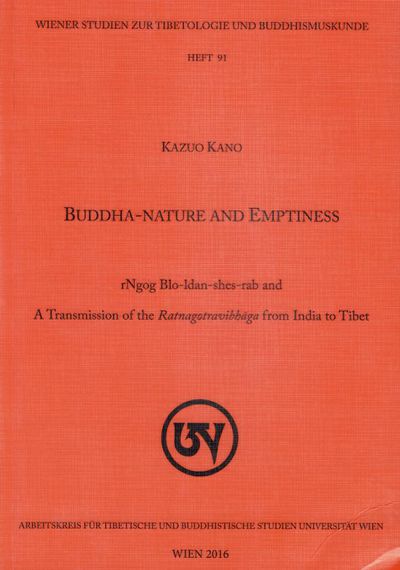Buddha-Nature and Emptiness
< Books
| Line 19: | Line 19: | ||
The second part of the book does for [[Ngok]] and his commentary what the first part of the book did for the ''[[Ratnagotravibhāga]]'': [[Kano, K.|Kano]] packs them in fascinating information about [[Ngok]]’s teachers and contemporaries, and he carefully unravels the complicated philosophical position [[Ngok]] established. This includes a lengthy chapter on [[Ngok]]’s Indian guru, [[Sajjana]], who was also the teacher to [[Tsen Khawoche]], a man who fully accepted the ontological aspect of buddha-nature and influenced the dzokchen and mahāmudrā interpretations of the doctrine. As a committed Mādhyamika, [[Ngok]] however was forced to confront what [[Kano, K.|Kano]] calls the “incompatibilities between the Buddha-nature and the Madhyamaka doctrines, especially with regard to the ultimate ontological status of Buddha-nature, which has never been accepted as Madhyamaka doctrine.” Step-by-step [[Kano, K.|Kano]] skillfully explains how [[Ngok]] did this by redefining three aspects of buddha-nature—''dharmakāya'', ''tathatā'', and ''gotra''—as resultant, intrinsic, and causal aspects of emptiness, respectively. Attentive to the historical nature of ideas, Kano ends the book with a lengthy section on [[Ngok]]’s impact on the many Tibetan ''[[Ratnagotravibhāga]]'' commentators who followed him; [[Ngok]]'s translation (and the only one of six to survive) became canonical, and his commentary has been continuously read in almost every Tibetan Buddhist educational center. | The second part of the book does for [[Ngok]] and his commentary what the first part of the book did for the ''[[Ratnagotravibhāga]]'': [[Kano, K.|Kano]] packs them in fascinating information about [[Ngok]]’s teachers and contemporaries, and he carefully unravels the complicated philosophical position [[Ngok]] established. This includes a lengthy chapter on [[Ngok]]’s Indian guru, [[Sajjana]], who was also the teacher to [[Tsen Khawoche]], a man who fully accepted the ontological aspect of buddha-nature and influenced the dzokchen and mahāmudrā interpretations of the doctrine. As a committed Mādhyamika, [[Ngok]] however was forced to confront what [[Kano, K.|Kano]] calls the “incompatibilities between the Buddha-nature and the Madhyamaka doctrines, especially with regard to the ultimate ontological status of Buddha-nature, which has never been accepted as Madhyamaka doctrine.” Step-by-step [[Kano, K.|Kano]] skillfully explains how [[Ngok]] did this by redefining three aspects of buddha-nature—''dharmakāya'', ''tathatā'', and ''gotra''—as resultant, intrinsic, and causal aspects of emptiness, respectively. Attentive to the historical nature of ideas, Kano ends the book with a lengthy section on [[Ngok]]’s impact on the many Tibetan ''[[Ratnagotravibhāga]]'' commentators who followed him; [[Ngok]]'s translation (and the only one of six to survive) became canonical, and his commentary has been continuously read in almost every Tibetan Buddhist educational center. | ||
|BookToc=* {{i|PREFACE|}} | |BookToc=* {{i|PREFACE|}} | ||
| − | * {{i|Introduction|i}} | + | * {{i|Introduction| i}} |
| − | * {{i|PART I: Historical and Doctrinal Background|5}} | + | * {{i|PART I: Historical and Doctrinal Background| 5}} |
| − | ** {{i|Chapter 1: The Authorship of the ''Ratnagotravibhāga'' and Its Transmission in India from the 5th to the 10th Century|17}} | + | ** {{i|Chapter 1: The Authorship of the ''Ratnagotravibhāga'' and Its Transmission in India from the 5th to the 10th Century| 17}} |
** {{i|Chapter 2: The Resurrection of the ''Ratnagotravibhāga'' in India in the Early 11th Century: Maitripa and Jñānasrimitra |43}} | ** {{i|Chapter 2: The Resurrection of the ''Ratnagotravibhāga'' in India in the Early 11th Century: Maitripa and Jñānasrimitra |43}} | ||
** {{i|Chapter 3: Ratnakarasanti’s Understanding of Buddha-nature |71}} | ** {{i|Chapter 3: Ratnakarasanti’s Understanding of Buddha-nature |71}} | ||
Revision as of 02:17, 29 January 2020
An essential study of a key text that presents buddha-nature theory and its transmission from India to Tibet, this book is the most thorough history of buddha-nature thought in Tibet and is exceptional in its level of detail and scholarly apparatus. It serves as a scholarly encyclopedia of sorts with extensive appendices listing every existent commentary on the Ratnagotravibhāga (Uttaratantraśāstra), as well as covering Ngok Lotsawa's commentarial text and his philosophical positions related with other Tibetan thinkers.
| Citation | Kano, Kazuo. Buddha-Nature and Emptiness: rNgog Blo-ldan-shes-rab and A Transmission of the Ratnagotravibhāga from India to Tibet. Wiener Studien zur Tibetologie und Buddhismuskunde 91. Vienna: Arbeitskreis für Tibetische und Buddhistische Studien Universität Wien, 2016. |
|---|---|

